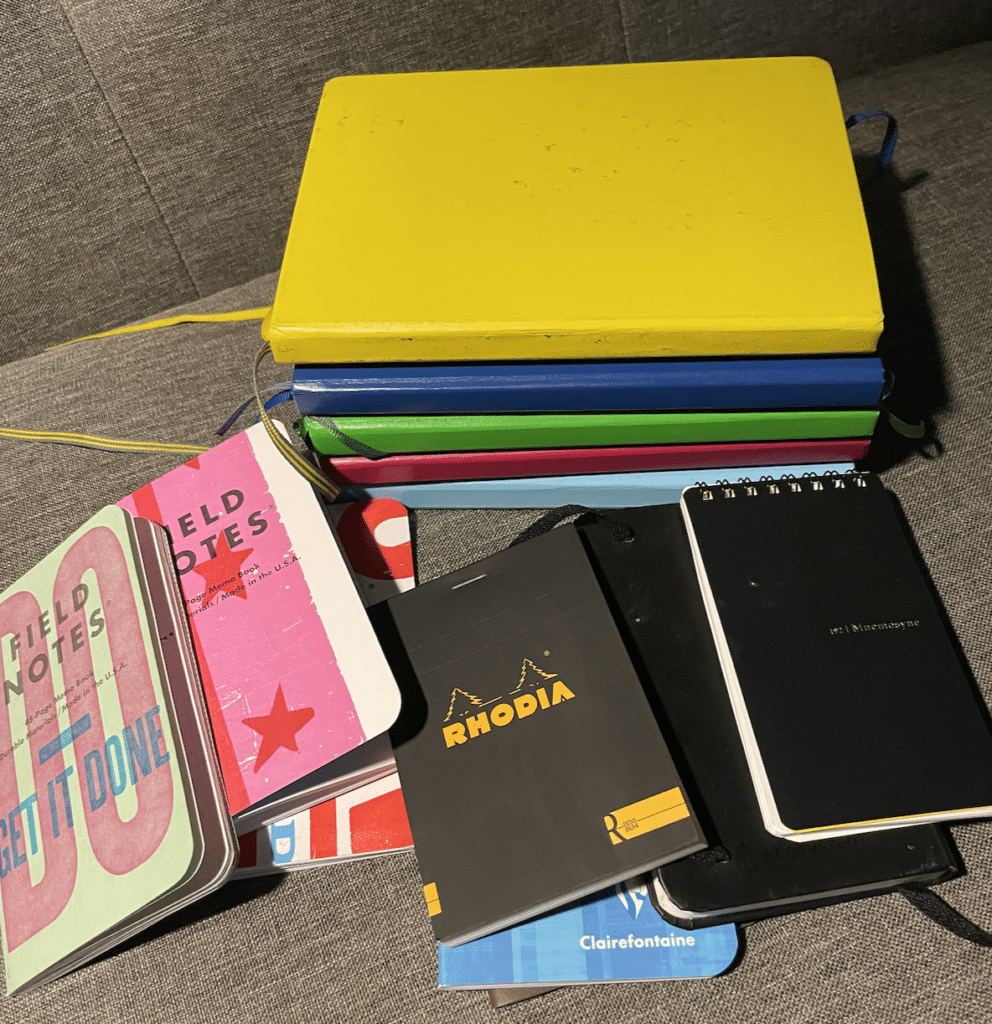I’ve spent a long time fighting a notebook addiction.
The smell of fresh paper, the crisp feel of a pristine cover, the promise of a blank page — for many, the allure of a new notebook is simply irresistible.

But what happens when this innocent pleasure turns into an addiction that leaves you drowning in a sea of half-used journals?
If you constantly buy new notebooks to “start fresh,” you’re not alone. Let’s explore this common struggle and discover practical ways to break free from the cycle.
Understanding Notebook Addiction
Unsurprisingly, the compulsion to buy new notebooks can come from a deeper psychological need.
For many, a fresh notebook represents a clean slate — a tangible symbol of new beginnings and endless possibilities. This desire to start fresh can be particularly strong for those grappling with perfectionism (raises hand) or struggling with mental health issues like anxiety.
Buying a new notebook can provide a temporary boost of dopamine, creating a sense of excitement and motivation. However, this feeling is often short-lived, leading to a cycle of buying more notebooks in search of that same high.
10 Smart Tips to Break the Notebook Addiction
1. Demystify Your Notebooks
One effective strategy is using your notebooks for mundane, everyday tasks. Write shopping lists, jot down quick notes, or scribble reminders. By treating your notebooks as utilitarian tools rather than precious objects, you can reduce their romantic allure and make it easier to use them without fear of “ruining” them.
2. Invest in One High-Quality Planner
Consider investing in a single, high-quality notebook to meet your needs. A versatile system like Midori’s Traveler’s Notebooks with interchangeable inserts can provide the flexibility of multiple notebooks while reducing the temptation to buy new ones constantly.
3. Declutter and Donate
Take time to sort through your existing collection. Be honest about which notebooks you’ll realistically use and consider donating the rest. Local schools, community centers, or art programs often welcome notebook donations, giving your unused journals a new purpose.
4. Embrace Digital Alternatives
While there’s something special about pen and paper, digital tools may work better for you. Consider a reusable notebook like the Rocketbook, which allows you to digitize your notes and erase pages for continual use. This can satisfy the desire for a “fresh start” without accumulating physical notebooks.
5. Restart Within Existing Notebooks
Challenge yourself to find creative ways to restart within partially used notebooks. Junk journaling is increasingly popular, where you fill a notebook with scraps, papers, designs, and all sorts of stuff around the house.
Use colorful washi tape to mark new sections, or simply flip to a fresh page and begin anew. Remember, a notebook doesn’t need to be completed chronologically to be valuable.
6. Identify Your Preferences
Reflect on what you truly value in a notebook. Is it the paper quality, the size, or specific features like dot grid pages? Once you’ve identified your ideal notebook, stick with it. This can reduce the temptation to try every new option that hits the market.
7. Create a Fake Shopping Experience
Box up all your unused notebooks and store them out of sight. When the urge to buy a new notebook strikes, “shop” from your own collection instead. This can satisfy the desire for something new without actually making a purchase.

8. Practice Mindful Purchasing
Before buying a new notebook, implement a waiting period. Ask yourself if you really need it or if you’re buying out of habit. Consider taking a photo of notebooks you’re tempted by instead of purchasing them immediately. This can often satisfy the initial urge without adding to your collection.
9. Challenge Perfectionism
Many notebook addicts struggle with the fear of “ruining” their notebooks. Practice accepting imperfection by intentionally making mistakes or starting in the middle of the notebook. Remember, a well-used notebook with crossed-out words and dog-eared pages tells a story of creativity and productivity.
10. Find Alternative Outlets
If the urge to start fresh is strong, look for other ways to satisfy this need. Start a new exercise routine, rearrange your workspace, or try a new hobby. These activities can provide the sense of renewal you’re seeking without adding to your notebook collection.
Download this cheatsheet and get expert solutions for the 13 most common pen problems.
Get The FREE CheatsheetMaximizing Your Existing Notebook Collection
Once you’ve curbed the impulse to buy new notebooks, focus on making the most of your existing collection.
Different notebooks can serve various purposes in your life:
- Use a sturdy, hardcover notebook for work meetings and important notes
- Keep a small, pocket-sized notebook for on-the-go ideas and observations
- Dedicate a larger, artist-quality notebook for sketching or journaling
By assigning specific roles to different notebooks, you can appreciate their unique qualities and use them more effectively.
The Journey to Recovery
Breaking any habit takes time and patience. Be kind to yourself as you work to overcome your notebook addiction. Celebrate small victories, like using up an entire notebook or resisting the urge to buy a new one.
Rather than constantly seeking the next new thing, you’ll learn to appreciate the notebooks you have, using them as tools for creativity, productivity, and self-expression.
Breaking free from notebook addiction isn’t about depriving yourself of the joy that stationery can bring. Instead, it’s about finding a balance that lets you enjoy notebooks mindfully and sustainably. Following these tips and focusing on the notebooks you already own, can help cultivate a more intentional and relationship with your collection (not to mention shelf space).
Remember, the true value of a notebook is in the thoughts, ideas, and memories you fill it with. So go ahead, open that notebook you’ve been saving, and start writing your story.
Liz
Hey, I'm Liz. I'm the founder of this thing. Pen-obsessed and a notebook nut, I love writing by hand. So I'm gonna talk about it on a computer.Download this cheatsheet and get expert solutions for the 13 most common pen problems.
Get The FREE Cheatsheet